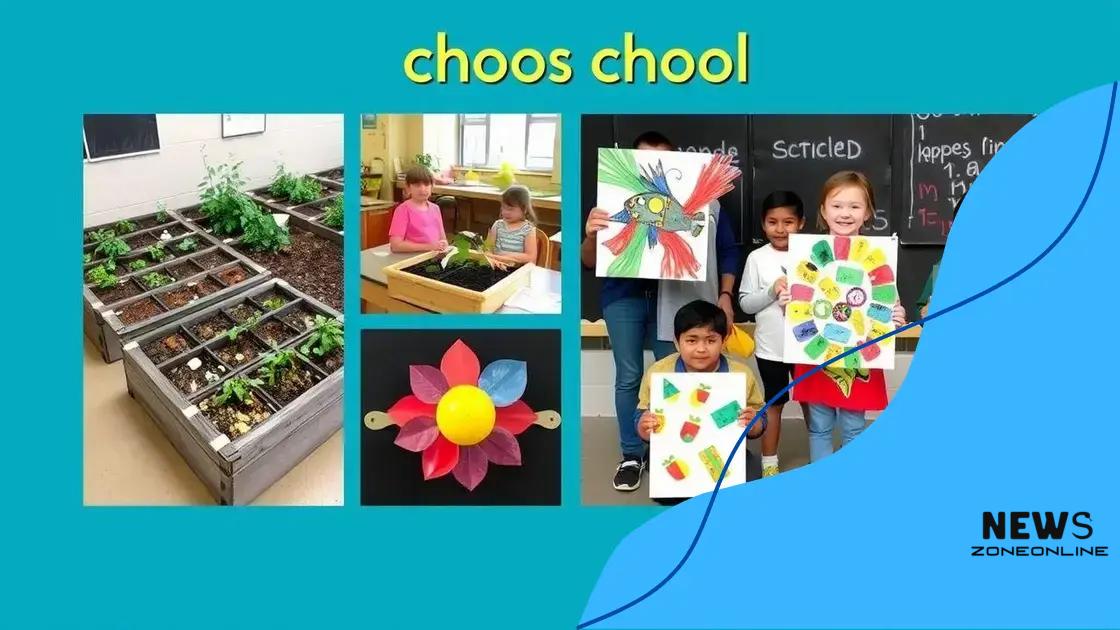Practical environmental education: sustainable projects in schools

Practical environmental education involves engaging students in sustainable projects to foster environmental awareness, develop essential skills, and promote community involvement for a healthier planet.
Practical environmental education is essential for nurturing eco-conscious students. Imagine classrooms buzzing with energy as students engage in projects that promote sustainability!
Understanding practical environmental education
Understanding practical environmental education is vital for creating an eco-conscious future. It involves teaching students about the environment in a way that is engaging and meaningful. Practical environmental education encourages hands-on experiences that foster a strong connection with nature.
Key Elements of Practical Environmental Education
This type of education is built on several key components:
- Experiential learning that creates lasting impressions.
- Integration with school curricula to provide context.
- Encouragement of critical thinking and problem-solving skills.
When students participate in real-world projects, they learn how to interact positively with their surroundings. Activities like tree planting or recycling initiatives help them understand the impact of their actions.
Benefits of Hands-On Learning
Engaging students with hands-on projects has multiple advantages. It not only enhances their knowledge but also:
- Boosts interest in environmental issues.
- Promotes teamwork and collaboration.
- Encourages responsibility towards the environment.
Moreover, practical environmental education can help schools build a sense of community. By involving local organizations, students gain support and resources for their initiatives. They become ambassadors for sustainability, inspiring others to take action.
Additionally, the joy of learning through practical activities can motivate students to pursue careers in environmental fields. They see the relevance of their studies and how they can contribute to a greener planet. This connection transforms education from a chore into a passion.
In summary, practical environmental education is a powerful tool that cultivates an appreciation for the environment. By integrating this approach in schools, we can inspire a generation committed to sustainability and stewardship.
Benefits of sustainable projects in schools
Benefits of sustainable projects in schools are vast and impactful. These initiatives not only help the environment but also foster a sense of responsibility and community among students. Implementing sustainability in education teaches children the importance of caring for the planet.
Environmental Awareness
One of the greatest advantages of sustainable projects is that they raise environmental awareness. When students engage in activities like recycling or energy conservation, they learn about the issues facing the planet. This knowledge cultivates a sense of concern for our world.
- Students learn to identify eco-friendly practices.
- They understand the consequences of pollution.
- They recognize the importance of biodiversity.
Such awareness often translates into lifelong habits. Students become more mindful of their consumption and understand how personal choices impact the environment.
Community Involvement
Sustainable projects also encourage community involvement. When schools partner with local organizations, everyone benefits. Students collaborate with community members to create gardens or clean up local parks. This teamwork strengthens local bonds and promotes a sense of belonging.
Additionally, these activities can inspire a collective effort toward sustainability. As students engage with their communities, they become leaders in promoting environmental stewardship.
Moreover, sustainable projects enhance students’ skills. They learn to work together, solve problems, and take initiative. These skills are vital for their future careers. Schools foster a new generation who are not only knowledgeable about the environment but also equipped to make a difference.
Enhanced learning opportunities also arise from sustainable initiatives. Students dive deep into subjects like science and ecology through hands-on experiences. This active learning can lead to better retention of information and a more profound passion for learning.
Creative ideas for school projects

Creative ideas for school projects can spark enthusiasm in students and promote active learning. These projects not only teach valuable skills but also engage students in meaningful environmental education. By utilizing creativity, schools can inspire students to think critically about sustainability.
Inventive Project Examples
One way to encourage creativity is through hands-on projects. Here are some ideas:
- Building raised garden beds to grow vegetables.
- Creating a composting system for organic waste.
- Designing a rainwater harvesting system to conserve water.
These projects allow students to experience the benefits of sustainability firsthand. For instance, growing vegetables can teach about nutrition and eco-friendly practices, while composting illustrates waste reduction and environmental impact.
Artistic Environmental Initiatives
In addition to hands-on activities, artistic projects can also foster eco-consciousness. Students can:
- Produce artwork from recycled materials.
- Create posters promoting environmental awareness.
- Hold a photography competition focused on nature.
Such artistic endeavors encourage students to express their thoughts about environmental issues. This leads to a deeper understanding of their relationship with nature, enhancing their connection to sustainability.
Furthermore, integrating technology can amplify project creativity. Students can create a digital campaign promoting energy conservation or develop a website showcasing their environmental initiatives.
Collaboration plays a crucial role in these projects. Working together fosters teamwork and problem-solving skills. As students brainstorm and execute projects, they learn the value of different perspectives in creating sustainable solutions.
Incorporating community involvement
Incorporating community involvement is crucial for enhancing practical environmental education in schools. When schools engage their local communities, students learn the importance of collaboration and shared responsibility for the environment. Community projects create a sense of ownership and connection.
Benefits of Community Partnerships
Schools can benefit greatly from forming partnerships with local organizations. Such collaborations can:
- Provide resources and expertise for projects.
- Foster mentorship opportunities for students.
- Increase visibility and support for sustainability efforts.
When community members share their knowledge, students gain real-world insights into environmental challenges. This direct interaction motivates students and makes learning more meaningful.
Examples of Involvement
There are numerous ways to incorporate community involvement into school projects. For instance, schools can:
- Organize clean-up days at local parks.
- Partner with local farms for gardening projects.
- Invite experts to speak on sustainability topics.
These activities not only enrich students’ learning but also strengthen bonds within the community. As students work alongside volunteers, they build relationships that last beyond the classroom.
Additionally, such involvement raises awareness about local environmental issues. Students learn to identify problems in their surroundings and feel empowered to take action. For example, seeing pollution in a nearby river can motivate them to organize clean-up efforts.
Moreover, community involvement cultivates leadership skills in students. They take initiative, plan events, and work collaboratively with others. This skill set is invaluable, preparing them for their future careers and civic responsibilities.
Measuring the impact of environmental initiatives
Measuring the impact of environmental initiatives is essential for understanding their effectiveness. Schools can evaluate their projects to see how well they are performing. This analysis helps to refine strategies and improve outcomes, ensuring that efforts in sustainability are truly making a difference.
Key Metrics to Consider
When measuring impact, schools should consider several key metrics:
- Reduction in waste produced by the school.
- Increased recycling rates among students and staff.
- Improvement in energy efficiency in school buildings.
These areas provide clear indicators of how well sustainability initiatives are working. Tracking these metrics allows schools to set achievable goals and observe progress over time.
Methods of Assessment
There are various methods for assessing the impact of environmental initiatives. Surveys can be distributed to students and staff to gauge their understanding and engagement with sustainability practices. Additionally, schools can utilize data collection methods such as:
- Conducting energy audits to check for efficiency.
- Monitoring waste disposal and recycling bins.
- Running assessments of student participation in eco-friendly programs.
Analyzing this data helps schools identify strengths and weaknesses in their projects. For instance, if recycling rates are low, it may indicate that more education is needed on how to recycle properly.
Moreover, schools can involve students in the evaluation process. Creating student-led committees to assess projects encourages ownership and accountability. Students can present their findings, contributing to a culture of continuous improvement.
Finally, sharing results with the community can boost engagement. Schools can host events to present their findings, showcasing their commitment to environmental stewardship. This transparent approach encourages further community involvement and support.
FAQ – Frequently Asked Questions about Practical Environmental Education in Schools
What are the benefits of implementing sustainable projects in schools?
Sustainable projects help students develop essential skills, increase environmental awareness, and promote community engagement.
How can community involvement enhance environmental education?
Community involvement allows students to collaborate with local organizations, making projects more impactful and fostering a sense of responsibility.
What metrics should schools use to measure the impact of their initiatives?
Schools should consider metrics such as waste reduction, recycling rates, and energy efficiency improvements to evaluate their projects’ effectiveness.
How can students take ownership of environmental initiatives?
By involving students in project planning and evaluation, schools can empower them to lead and take accountability for their sustainability efforts.





